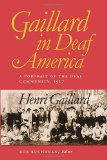

 |

|

The average rating for Gaillard in Deaf America: A Portrait of the Deaf Community, 1917 (Gallaudet Classics in Deaf Studies Series, Vol. 3) based on 2 reviews is 3 stars.
Review # 1 was written on 2016-10-20 00:00:00 Stephane Wellens Stephane WellensFrom what I remember (it's been a few months since I've put this book down), Hardin delves into a few different theories of what causes people to self-sort into groups, what these groups could look like, why these groups might (or might not) compete for "resources", within and among groups. While chock-full of examples to reinforce his thoughts, Hardin falls into jargon-riddled academic-speak, making it tough to follow at times. Overall, this definitely worth reading. |
Review # 2 was written on 2009-08-21 00:00:00 Sarkis Sarkissian Sarkis SarkissianI'm sure I will have to read this book again in the future. It was a good book but there were some concepts that I was unfamiliar with but, fortunately they don't take away from the understanding that can be gained from reading this book. It breaks down the "Prisoner's Dilemma" into how it is a form of exchange & how that governs a lot of the way we function in society especially in regards to group. Part of why one may identify with a group has to do with benefits, meaning, who benefits & how they benefit with identifying with one group or another. It goes into what may be some deciding factors for joining, staying with & even eventually leaving a group based on the cost of the decision to do one over the other. Depending on the nature of this group formation, the cost to others or outsiders is brought up & how that may increase group tensions. The role exclusion plays, especially in group conflicts that are violent in ways that aren't always physical, as it can be systemic & economic, is explored & so is the importance of it's role in group conflicts that tend to be violent & extremely divisive. The importance of norms & how they can reinforce group identity shows how beautiful & subtle a pervasive system can be without people even realizing it. The role ethnic identification plays, especially in a society where control of resources has been made key, & how that can cause one to be a friend one day & a bloodthirsty enemy the next is explained over several chapters with very poignant examples given.Despite the negatives that can come from group conflict, group identification isn't inherently bad or good either. The reasons for identification & how it expresses itself in society as well as the conditions of society have a lot do with it. In cases of exclusion & conflict, being identified with the dominant group can allow one considerably more freedom to stray from it's norms with significantly less fear of being excluded themselves if the society is more or less stable. There is much to take away from this book & again, I'm sure I will have to read it again in the future. It's a good book & can help you understand why it is hard for various groups to come to some understanding & consensus in society. Two important questions it made me feel it is always important to ask: Who benefits? And how? |
CAN'T FIND WHAT YOU'RE LOOKING FOR? CLICK HERE!!!